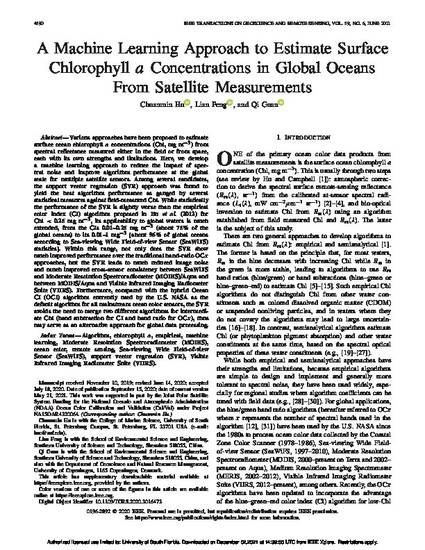
- Oceans,
- Machine learning algorithms,
- Water,
- Machine learning,
- Image color analysis,
- Sea measurements,
- Sensors
Various approaches have been proposed to estimate surface ocean chlorophyll a concentrations (Chl, mg m -3 ) from spectral reflectance measured either in the field or from space, each with its own strengths and limitations. Here, we develop a machine learning approach to reduce the impact of spectral noise and improve algorithm performance at the global scale for multiple satellite sensors. Among several candidates, the support vector regression (SVR) approach was found to yield the best algorithm performance as gauged by several statistical measures against field-measured Chl. While statistically the performance of the SVR is slightly worse than the empirical color index (CI) algorithm proposed in Hu et al. (2012) for Chl <; 0.25 mg m -3 , its applicability to global waters is much extended, from the CIs 0.01-0.25 mg m -3 (about 75% of the global oceans) to its 0.01-1 mg -3 [about 96% of global oceans according to Sea-viewing Wide Field-of-view Sensor (SeaWiFS) statistics]. Within this range, not only does the SVR show much improved performance over the traditional band-ratio OC x approaches, but the SVR leads to much reduced image noise and much improved cross-sensor consistency between SeaWiFS and Moderate Resolution Spectroradiometer (MODIS)/Aqua and between MODIS/Aqua and Visible Infrared Imaging Radiometer Suite (VIIRS). Furthermore, compared with the hybrid Ocean CI (OCI) algorithm currently used by the U.S. NASA as the default algorithm for all mainstream ocean color sensors, the SVR avoids the need to merge two different algorithms for intermediate Chl (band subtraction for CI and band ratio for OC x), thus may serve as an alternative approach for global data processing.
IEEE Transactions on Geoscience and Remote Sensing, v. 59, issue 6, p. 4590-4607
Available at: http://works.bepress.com/chuanmin_hu/55/
